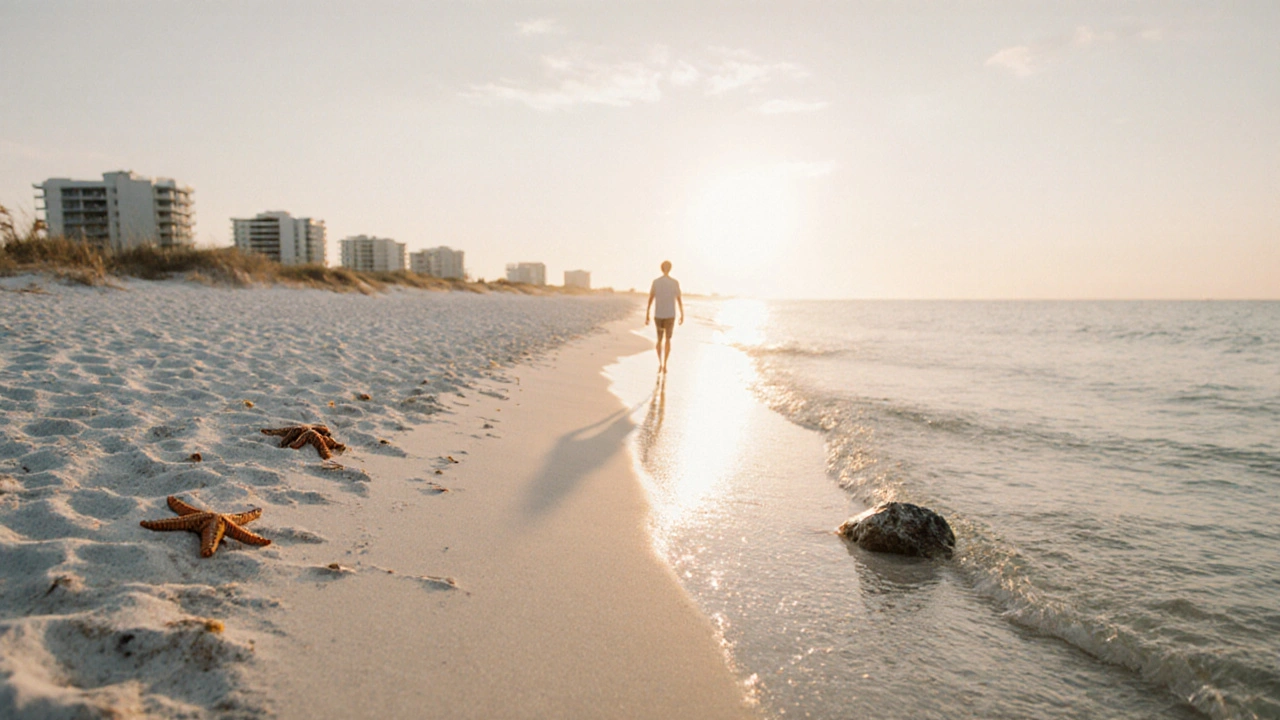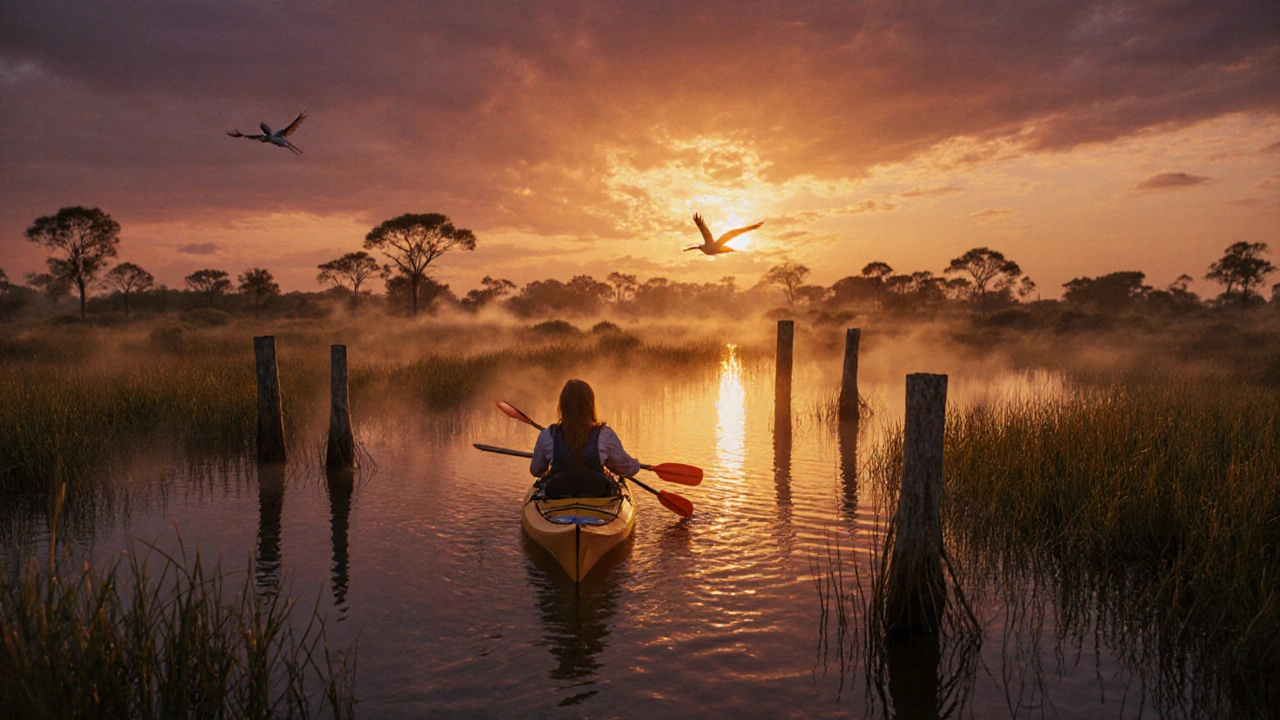Florida isn’t just about theme parks and neon-lit boardwalks. If you’ve only seen Orlando or Miami, you’ve seen a fraction of what this state holds. The real magic? It’s in the quiet corners where the water glows at sunset, where manatees drift through warm springs, and where pine forests meet white sand that stretches for miles without a single hotel in sight.
The Everglades at sunset
Most people think of the Everglades as a swamp. It’s not. It’s a slow-moving river of grass, 1.5 million acres of living wetland that breathes with the seasons. At dusk, the air fills with the sound of croaking alligators and the flapping of herons taking flight. The light turns everything gold-cypress knees, sawgrass, even the mist rising off the water. You can kayak through Shark Valley at twilight, paddle past turtles sunning on logs, and watch the sky shift from orange to deep violet. No crowds. No signs. Just nature doing what it’s done for thousands of years.
Clearwater Beach and the Gulf Coast
Clearwater Beach isn’t just sand and sun. It’s the kind of place that makes you forget why you ever wanted to go anywhere else. The water is so clear you can see your toes 5 feet down. The sand? Powder-fine and so white it reflects the light like a mirror. At low tide, you’ll find starfish clinging to rocks and tiny crabs scuttling sideways. The beach runs for 3 miles without a single high-rise. And every evening, the sun drops behind the Gulf, painting the clouds in streaks of pink and purple. Locals call it the best sunset in Florida-and they’re not wrong.
Key West and the Florida Keys
Key West isn’t just the southernmost point on the U.S. map. It’s a place where time slows down. The pastel houses, the hammocks strung between palm trees, the smell of fresh conch fritters in the air. But the real beauty? The water. Dive or snorkel at John Pennekamp Coral Reef State Park, and you’ll swim through coral gardens teeming with parrotfish, angelfish, and sea turtles. The reef is the only living coral barrier in the continental U.S. And at night, the stars here are so bright, you can see the Milky Way stretching from horizon to horizon. No city lights. No noise. Just the sound of waves and the quiet hum of the ocean.
St. Augustine’s Anastasia State Park
St. Augustine gets all the attention for its Spanish fort and cobblestone streets. But just a few miles north, Anastasia State Park hides one of Florida’s most untouched stretches of coastline. Here, the dunes rise 60 feet high, covered in sea oats that sway like waves themselves. The beach is wide enough to walk for miles without seeing another person. At sunrise, the tide leaves behind tidal pools filled with tiny crabs and shells. The park’s salt marshes are home to ospreys, dolphins, and even the occasional manatee. And the best part? You can camp under the stars with only the sound of the wind and the ocean.

Apalachicola Bay and the Forgotten Coast
Most tourists skip this part of Florida. And that’s exactly why it’s so beautiful. Apalachicola Bay is where the Apalachicola River meets the Gulf. The water is brackish, rich with nutrients, and home to the best oysters in the country. The shoreline is lined with salt marshes, tidal creeks, and old fishing shacks that haven’t changed in 50 years. You can rent a kayak and paddle through narrow channels where herons stand like statues. At dusk, the sky turns a deep blue, and the water reflects the stars like glass. This is Florida as it was before the condos came. Quiet. Wild. Real.
Why these places matter
Florida’s beauty isn’t in the neon lights or the souvenir shops. It’s in the silence between the waves. It’s in the way the air smells after a summer rain in the Everglades. It’s in the fact that you can stand on a beach at dawn and not see a single footprint but your own. These five places aren’t just scenic-they’re alive. They change with the tides, the seasons, the weather. They don’t need to be marketed. They don’t need to be crowded. They just are.
What most people miss
Everyone talks about Disney, Miami, or Daytona. But those places are designed for crowds. The real Florida is the one you find when you turn off the highway, roll down your windows, and let the GPS lead you somewhere with no name. You won’t find a TripAdvisor rating for the hidden cove near Cedar Key. You won’t see a sign pointing to the best sunrise over the Okefenokee Swamp. But if you’re willing to drive a little farther, walk a little longer, and wait a little quieter-you’ll find something no theme park can give you: peace.

When to go
Florida’s beauty changes with the season. Spring (March-May) is perfect for the Everglades and the Keys-mild temps, fewer bugs, and clear water. Fall (September-November) brings calm seas to the Gulf Coast and fewer tourists. Summer? Hot and humid, but great for springs like Silver Springs or Rainbow Springs, where the water stays a steady 72°F. Winter is ideal for manatee watching in Crystal River, where you can swim alongside these gentle giants in their warm-water refuge.
What to pack
- Water shoes for rocky shores and coral reefs
- Reusable water bottle-many parks have refill stations
- Lightweight rain jacket-Florida’s afternoon storms are sudden
- Binoculars for birdwatching in the Everglades or along the coast
- Small first-aid kit with antiseptic wipes and insect repellent
How to avoid the crowds
- Visit state parks on weekdays-weekends fill up fast
- Arrive at sunrise or stay until sunset-most tourists leave by noon
- Choose lesser-known spots: instead of Clearwater, try Fort De Soto Park. Instead of Key West, try Islamorada
- Book campsites or kayak rentals in advance-many fill up weeks ahead
Final thought
Florida’s most beautiful part isn’t a single place. It’s the feeling you get when you realize this state isn’t just a vacation spot-it’s a living, breathing ecosystem that’s been here long before you showed up. And if you take the time to listen, to watch, to sit still-you’ll realize it’s still here, waiting for you, even if you’re the only one there.
Is Florida’s most beautiful part crowded with tourists?
It depends on where you go. Popular spots like Miami Beach or Clearwater can get packed, especially in winter. But Florida has over 175 state parks, many of which see fewer than 10,000 visitors a year. Places like Apalachicola Bay, Anastasia State Park, and the backcountry of the Everglades are rarely crowded. The key is going off-season, on weekdays, and choosing lesser-known areas.
What’s the best time of year to visit Florida’s natural areas?
Spring (March to May) and fall (September to November) are ideal. Temperatures are comfortable, bugs are fewer, and water clarity is at its best. Winter is great for manatee watching in Crystal River. Summer is hot and humid, but perfect for swimming in freshwater springs like Silver Springs, where the water stays cool year-round.
Can you see wildlife in Florida’s beautiful places?
Absolutely. The Everglades is home to alligators, panthers, and over 350 species of birds. The Gulf Coast hosts dolphins, sea turtles, and manatees. Apalachicola Bay has ospreys, eagles, and the famous oysters. Just keep your distance, don’t feed animals, and follow park guidelines. Many of these creatures are protected-and they’re more likely to be seen if you’re quiet and patient.
Are Florida’s natural areas safe for families?
Yes, if you plan ahead. State parks have well-marked trails, picnic areas, and restrooms. Avoid swimming in the Everglades due to alligators and murky water. Stick to designated swimming areas like springs or beaches. Always check park alerts for weather or wildlife activity. Kids love spotting crabs in tidal pools and feeding ducks at park ponds. Bring snacks, water, and sunscreen-Florida’s sun is strong even on cloudy days.
Do you need a car to explore Florida’s most beautiful spots?
Yes, absolutely. Most of Florida’s natural beauty is outside city limits. Public transit doesn’t reach places like the Forgotten Coast, the Everglades backcountry, or Anastasia State Park. A car gives you freedom to explore at your own pace. Rent one if you’re flying in-many rental agencies offer SUVs with roof racks for kayaks or bikes.

